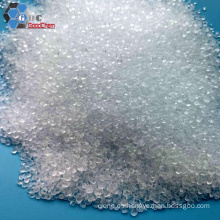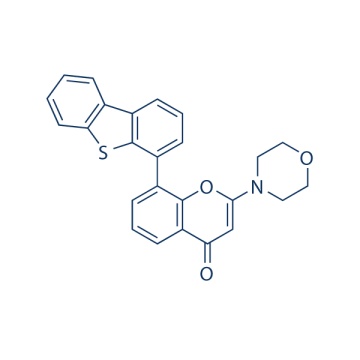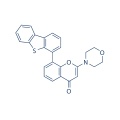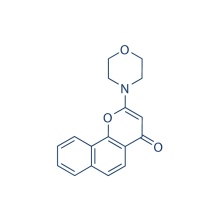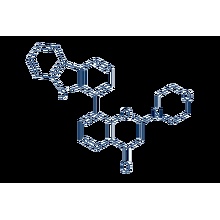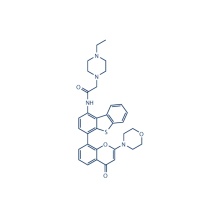.cp_wz tabla {borde superior: 1px sólido #ccc; borde izquierdo: 1px sólido #ccc; } .cp_wz table td {borde derecho: 1px sólido #ccc; borde inferior: 1px sólido #ccc; padding: 5px 0px 0px 5px;} .cp_wz table th {border-right: 1px solid #ccc; border-bottom: 1px solid #ccc; padding: 5px 0px 0px 5px;} \ n Peso molecular: 413.49 NU7441 (KU-57788) es un inhibidor de DNA-PK altamente potente y selectivo con IC50 de 14 nM y también inhibe PI3K con IC50 de 5 μM. \ n NU7441 aumenta el persistencia de focos de γH2AX después de daño en el ADN inducido por radiación ionizante o etopósido. NU7441 (0,5 µM o 1 µM) aumenta apreciablemente la acumulación de G2-M inducida por radiación ionizante, etopósido y doxorrubicina en las células SW620 y LoVo. NU7441 provoca la persistencia de la rotura de la doble hebra del ADN inducida por doxorrubicina y radiación ionizante y también disminuye ligeramente la actividad de recombinación homóloga M059-Fus-1 con dominio de PK de ADN y M059 J deficiente en PK de ADN de células tumorales humanas. NU7441 inhibe la hiperfosforilación de RPA p34 inducida por UV de una manera dependiente de la dosis tanto en las células que carecen como en las que expresan la polimerasa η. NU7441 aumenta los niveles de focos de γH2AX inducidos por fludarabina y, en consecuencia, disminuyó la muerte celular inducida por fludarabina en células de leucemia linfocítica crónica. NU7441 también inhibe la autofosforilación y reparación de ADN-PKcs inducidas por mitoxantrona en células de leucemia linfocítica crónica. NU7441 administrado por vía intraperitoneal a una dosis de 10 mg / kg mantiene durante al menos 4 horas muestra no tóxico y aumenta el retraso del crecimiento tumoral inducido por etopósido 2 veces en ratones que portan xenoinjertos SW620. Protocolo (solo como referencia) Ensayo celular: [2]
|
Cell lines
|
SW620, LoVo, V3-YAC and V3 cells
|
|
Concentrations
|
0.5 μM or 1 μM
|
|
Incubation Time
|
17 hours
|
|
Method
|
The effect of NU7441 on cellular survival following exposure to etoposide, doxorubicin, and ionizing radiation is measured in SW620, LoVo, V3, and V3-YAC cells by clonogenic assays. Briefly, growing cells in six-well plates or 6-cm dishes are exposed to etoposide or doxorubicin with or without NU7441 (0.5 or 1.0 μM) for 16 hours. For radiosensitization studies, NU7441 is added to the cells 1 hour before irradiation. V3 and V3-YAC cells are exposed to γ-irradiation (3.1 Gy/min 137Cesium). SW620 and LoVo are exposed to X-irradiation (2.9 Gy/min at 230 kV, 10 mA) due to the equipment available. After irradiation, the cells are incubated with or without NU7441 for a further 16 hours. Cells are then harvested by trypsinization, counted, and seeded into 10-cm diameter Petri dishes at densities varying from 100 to 105 per dish in drug-free medium for colony formation. Colonies are stained with crystal violet after 10 to 14 days and counted with an automated colony counter. The survival reduction factor (SRF) is calculated as the surviving fraction of cells in the absence of NU7441 divided by the surviving fraction of cells in the presence of NU7441 for any given dose or concentration of cytotoxic agent. The dose modification ratio (DMR90) is calculated as the concentration/dose of cytotoxic agent required to kill 90% of the cells in the absence of NU7441 divided by the concentration/dose of cytotoxic agent required to kill 90% of the cells in the presence of NU7441.
|
Estudio con animales: [2]
|
Animal Models
|
Female rude mice bearing SW620 xenografts
|
|
Formulation
|
Sterile 0.9% sodium chloride solution
|
|
Dosages
|
10 mg/kg
|
|
Administration
|
Intraperitoneally administrated
|
Conversión de diferentes modelos de animales basados en BSA (valor basado en datos del Borrador de Directrices de la FDA)
|
Species
|
Baboon
|
Dog
|
Monkey
|
Rabbit
|
Guinea pig
|
Rat
|
Hamster
|
Mouse
|
|
Weight (kg)
|
12
|
10
|
3
|
1.8
|
0.4
|
0.15
|
0.08
|
0.02
|
|
Body Surface Area (m2)
|
0.6
|
0.5
|
0.24
|
0.15
|
0.05
|
0.025
|
0.02
|
0.007
|
|
Km factor
|
20
|
20
|
12
|
12
|
8
|
6
|
5
|
3
|
|
Animal A (mg/kg) = Animal B (mg/kg) multiplied by
|
Animal B Km
|
|
Animal A Km
|
Por ejemplo, para modificar la dosis de resveratrol utilizada para un ratón (22,4 mg / kg) a una dosis basada en el BSA para una rata, multiplique 22,4 mg / kg por el factor Km para un ratón y luego divida por el factor Km para una rata. Este cálculo da como resultado una dosis equivalente para ratas de resveratrol de 11,2 mg / kg.
|
Rat dose (mg/kg) = mouse dose (22.4 mg/kg) ×
|
mouse Km(3)
|
= 11.2 mg/kg
|
|
rat Km(6)
|
Información química
|
Molecular Weight (MW)
|
413.49
|
|
Formula
|
C25H19NO3S
|
|
CAS No.
|
503468-95-9
|
|
Storage
|
3 years -20℃Powder
|
|
6 months-80℃in solvent (DMSO, water, etc.)
|
|
Synonyms
|
|
|
Solubility (25°C) *
|
In vitro
|
DMSO
|
3 mg/mL
(7.25 mM)
|
|
Water
|
<1 mg/mL
(
|
|
Ethanol
|
<1 mg/mL
(
|
* <1 mg/ml means slightly soluble or insoluble.
* Please note that Selleck tests the solubility of all compounds in-house, and the actual solubility may differ slightly from published values. This is normal and is due to slight batch-to-batch variations.
|
|
Chemical Name
|
4H-1-Benzopyran-4-one, 8-(4-dibenzothienyl)-2-(4-morpholinyl)-
|
Calculadora de molaridad Calculadora de dilución Calculadora de peso molecular
Grupos de Producto : PI3K / Akt / mTOR > Inhibidor de ADN-PK

